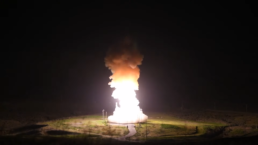This week, the US tested ICBMs off the California coast. These warheads, which are one of the main contributors to America’s ballooning military budget, are not only strategically impractical but a threat to the lives of millions.
By Emma Claire Foley, Jacobin
This week, the United States conducted two intercontinental ballistic missile (ICBM) test launches from Vandenberg Space Force Base on the California coast, 150 miles northwest of Los Angeles. Usually, these tests happen two or three times a year, when missiles usually kept in underground silos in several western states are transported to the base to demonstrate that the United States could, if it chose, use its nuclear weapons.

But for months, activists who monitor and work to critically publicize these launches have waited for one to be announced — which often happens with only a few days’ warning. The pair of tests this week were the first in over six months, since the last one, in November 2023, failed.
The test schedule has also been stymied by world affairs. In April 2022, the US Department of Defense announced that ICBM tests would be paused because of their escalatory potential in the context of the war in Ukraine. That war, and the nuclear threats that have accompanied it, continue, but without further acknowledgments of the risk-increasing aspect of the ICBMs.
Failed tests and nuclear threats are by no means the only issues dogging the program. Late last year, it was announced that the Sentinel program, which would wholly replace the existing ICBM force and originally came with an estimated total cost of nearly $300 billion, was behind schedule and 37 percent over budget, triggering a congressional review. No less than the ranking Democrat on the House Armed Services Committee, Adam Smith, published an op-ed in Newsweek suggesting the United States consider alternatives to going through with the Sentinel program as planned.
Recent Posts
‘Unconstitutional. Unethical. Authoritarian.’ ICE Bars Millions Of Immigrants From Bond Hearings
July 18, 2025
Take Action Now One watchdog said the new policy “seems like a blatant attempt to stop them from exercising their right to due process.”……
Americans Are Not Nearly Alarmed Enough About Climate Change
July 18, 2025
Take Action Now Americans still don’t comprehend how imminent, dangerous, and far-reaching the threat is—and journalists are partly to blame.By…
The IRS Is Building A Vast System To Share Millions Of Taxpayers’ Data With ICE
July 17, 2025
Take Action Now ProPublica has obtained the blueprint for the Trump administration’s unprecedented plan to turn over IRS records to Homeland Security…
Israel’s Sudden Assault On Syria Is Unchecked Aggression
July 17, 2025
Take Action Now Jerusalem is bombing Damascus and threatening al-Sharaa’s rule, while Washington was hoping to help the nascent government on…




